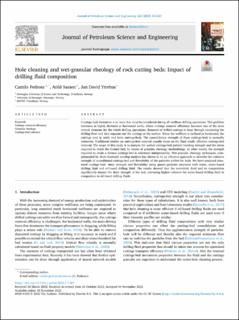| dc.contributor.author | Pedrosa, Camilo | |
| dc.contributor.author | Saasen, Arild | |
| dc.contributor.author | Ytrehus, Jan David | |
| dc.date.accessioned | 2022-11-24T07:53:45Z | |
| dc.date.available | 2022-11-24T07:53:45Z | |
| dc.date.created | 2022-11-23T10:29:45Z | |
| dc.date.issued | 2022 | |
| dc.identifier.citation | Journal of Petroleum Science and Engineering, 2023, 220, 1-8. | en_US |
| dc.identifier.issn | 0920-4105 | |
| dc.identifier.uri | https://hdl.handle.net/11250/3033771 | |
| dc.description.abstract | Cuttings-beds formation is an issue that must be considered during all wellbore drilling operations. This problem increases at highly deviated or horizontal wells, where cuttings removal efficiency becomes one of the most critical elements for the whole drilling operations. Removal of drilled cuttings is done through circulating the drilling fluid and then separate out the cuttings at the surface. When the wellbore is inclined or horizontal, the cuttings tend to settle and form cuttings-beds. The consolidation strength of these cuttings-beds is normally unknown. Traditional studies on cuttings-bed removal usually focus on the final result: effective cuttings-bed removal. The scope of this study is to analyze the wetted cuttings-bed particle bonding strength and the stress required to break the formed bed, by means of granular rheology methodology. In other words, the strength required to erode a formed cuttings-bed is addressed independently. Wet-granular rheology techniques, complemented by Mohr-Coulomb envelop analysis has shown to be an effective approach to describe the cohesive strength of consolidated cuttings-bed and flowability of the particles within the beds. We have analyzed simulated cuttings-beds’ shear strength and flowability using quartz particles saturated with water, water-based drilling fluid and oil-based drilling fluid. The results showed that the interstitial fluid and its composition significantly impact the shear strength of the bed, conveying higher cohesion for water-based drilling fluid in comparison to oil-based drilling fluids. | en_US |
| dc.language.iso | eng | en_US |
| dc.publisher | Elsevier | en_US |
| dc.rights | Navngivelse 4.0 Internasjonal | * |
| dc.rights.uri | http://creativecommons.org/licenses/by/4.0/deed.no | * |
| dc.subject | Cuttings-bed cohesion | en_US |
| dc.subject | Granular rheology | en_US |
| dc.subject | Cuttings removal efficiency | en_US |
| dc.title | Hole cleaning and wet-granular rheology of rock cutting beds: Impact of drilling fluid composition | en_US |
| dc.title.alternative | Hole cleaning and wet-granular rheology of rock cutting beds: Impact of drilling fluid composition | en_US |
| dc.type | Peer reviewed | en_US |
| dc.type | Journal article | en_US |
| dc.description.version | publishedVersion | en_US |
| dc.rights.holder | © 2022 The Authors. Published by Elsevier B.V. | en_US |
| dc.source.pagenumber | 1-8 | en_US |
| dc.source.volume | 220 | en_US |
| dc.source.journal | Journal of Petroleum Science and Engineering | en_US |
| dc.identifier.doi | 10.1016/j.petrol.2022.111267 | |
| dc.identifier.cristin | 2078978 | |
| dc.relation.project | Norges forskningsråd: 294688 | en_US |
| dc.source.articlenumber | 111267 | en_US |
| cristin.ispublished | true | |
| cristin.fulltext | original | |
| cristin.qualitycode | 2 | |

